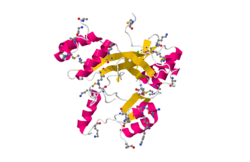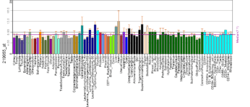References
- 1 2 3 GRCh38: Ensembl release 89: ENSG00000240563 - Ensembl, May 2017
- ↑ "Human PubMed Reference:".
- ↑
Iwabuchi KA, Yamakawa T, Sato Y, Ichisaka T, Takahashi K, Okita K, Yamanaka S (May 2011). "ECAT11/L1td1 is enriched in ESCs and rapidly activated during iPSC generation, but it is dispensable for the maintenance and induction of pluripotency". PLOS ONE. 6 (5): e20461. doi:10.1371/journal.pone.0020461. PMC 3102727. PMID 21637830.
- ↑
Närvä E, Rahkonen N, Emani MR, Lund R, Pursiheimo JP, Nästi J, Autio R, Rasool O, Denessiouk K, Lähdesmäki H, Rao A, Lahesmaa R (March 2012). "RNA-binding protein L1TD1 interacts with LIN28 via RNA and is required for human embryonic stem cell self-renewal and cancer cell proliferation". Stem Cells. 30 (3): 452–60. doi:10.1002/stem.1013. PMC 3507993. PMID 22162396.
- ↑
Wong RC, Ibrahim A, Fong H, Thompson N, Lock LF, Donovan PJ (April 2011). "L1TD1 is a marker for undifferentiated human embryonic stem cells". PLOS ONE. 6 (4): e19355. doi:10.1371/journal.pone.0019355. PMC 3084827. PMID 21559406.
- ↑
Yamamoto E, Toyota M, Suzuki H, Kondo Y, Sanomura T, Murayama Y, Ohe-Toyota M, Maruyama R, Nojima M, Ashida M, Fujii K, Sasaki Y, Hayashi N, Mori M, Imai K, Tokino T, Shinomura Y (October 2008). "LINE-1 hypomethylation is associated with increased CpG island methylation in Helicobacter pylori-related enlarged-fold gastritis". Cancer Epidemiol Biomarkers Prev. 17 (10): 2555–64. doi:10.1158/1055-9965.EPI-08-0112. PMID 18842996.




